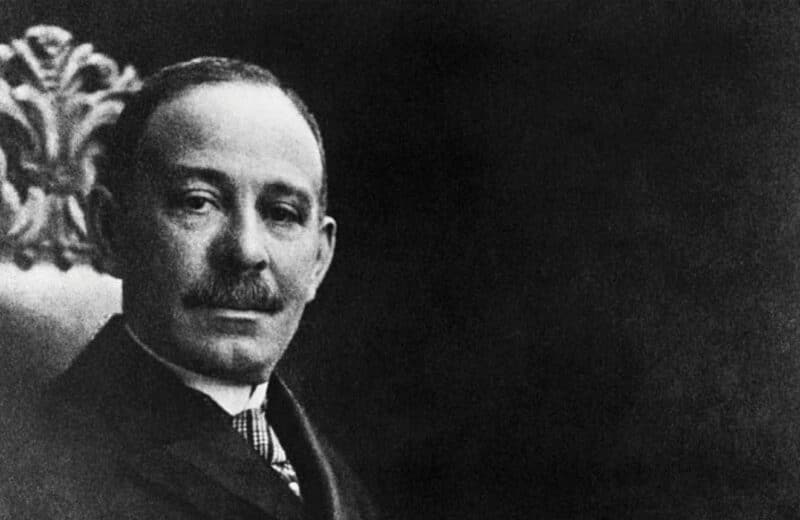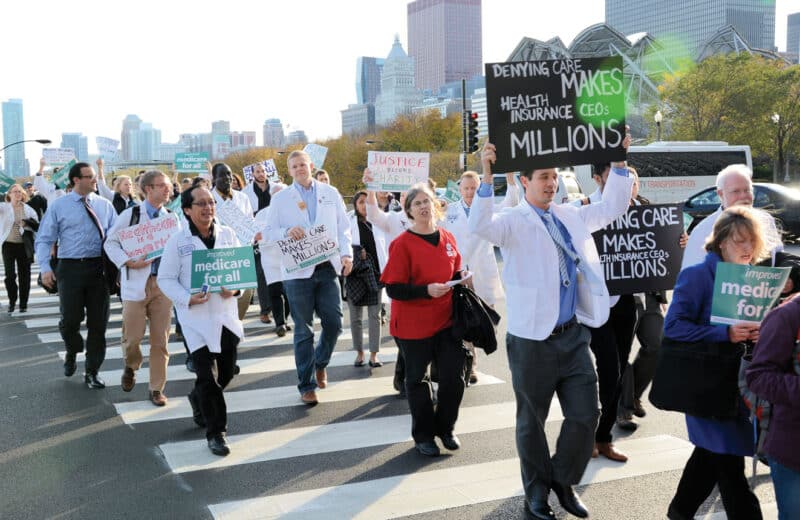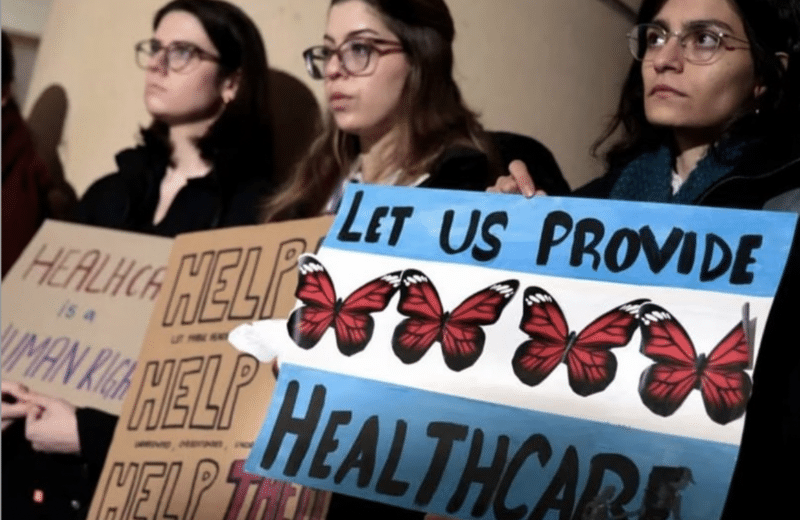Chicago groups provide healthcare to the homeless
Photo by Jim Vondruska
Colorful tents line the sidewalks under the Lake Shore Drive viaducts at Lawrence Avenue and Wilson Avenue. They’re home to a rotating cast of Chicago’s homeless who have sought refuge and also found community there. Some have been staying for months, some for days, but all face varying degrees of health issues, from diabetes and heart disease to mental illness and substance abuse.
But there’s more on their minds than their health. Chicago’s homeless face day-to-day survival challenges and regularly run the risk of medical emergencies such as hypothermia, heat stroke and traumatic brain injury. “If you don’t have housing, it’s very hard to think about how you’ll stay healthy,” says Avijit Ghosh, PhD, CEO of University of Illinois Hospital and Clinics.
Graham Bowman, an attorney with the Law Project of the Chicago Coalition for the Homeless, adds, “It’s a vicious cycle when a person becomes homeless because of a health issue, and then that health issue gets worse because they are homeless and don’t have the resources to manage or treat their condition.”
Carol worries about exactly that. She recently arrived at the Lawrence Avenue encampment, bringing her dogs Bella and Chief, as well as a list of health conditions including multiple sclerosis, diabetes and spinal stenosis. She chose the encampment, in part, to be close to Weiss Memorial Hospital, where she occasionally receives care.
For years, Carol had rented an apartment not far from the tent city. She would regularly walk her dogs under the Lake Shore Drive overpasses, praying for the people at the encampments. But after months of back and forth with her landlord, Carol was evicted.
“Now I’m here,” she says, her eyes filling with tears even as she smiles, her silver hair pulled back from her face in a short ponytail.
Addressing mental health
The city is planning to rehab the decaying bridges over Lawrence and Wilson avenues, potentially forcing homeless individuals out, according to the Chicago Sun-Times. But the Lawrence and Wilson encampments aren’t the only place Chicago’s homeless have set up makeshift shelters. They live under expressway overpasses, in vacant doorways downtown, on Lower Wacker Drive and on CTA trains and buses.
“It’s a complicated web, and the elephant in the room around all of this is mental health,” says Robin Varnado, regional director of operations and behavioral health at Erie Family Health Center, which has clinic locations throughout Chicago.
Chicago has 5,889 homeless people, the lowest figure in a decade, according to the city’s 2016 Point-in-Time Homeless count. Nationally, the homeless population totaled 549,928.
Some have been staying [under the viaducts] for months, some for days, but all face varying degrees of health issues, from diabetes and heart disease to mental illness and substance abuse.
Roughly a quarter of Chicago’s homeless population reported having substance abuse issues, and approximately the same amount said they had received mental health services. One in four said they had experienced domestic violence.
Mental health issues are front and center. Many of the homeless patients who come through Erie Family Health Center need basic behavioral health attention and sometimes more extensive psychiatric care or medication, Varnado says.
“The uniqueness of Erie is that if a patient comes in and the staff recognizes that they may be depressed, we have a behavioral health specialist on the floor on call. They can do a quick intervention and figure out what’s going on,” Varnado explains.
For example, a homeless patient with bipolar disorder may not be taking medication because he lost his health insurance. In that situation, the behavioral health specialist will call an internal psychiatric specialist and figure out how to get the person back on medication or seeing a long-term therapist.
Issues of trust
When people who are homeless get physically sick, they tend to put off going to a doctor until the illness balloons beyond their control. Many factors are at play, including lack of healthcare, lack of money and lack of transportation. Without a consistent relationship with a primary care physician, they often end up turning to emergency departments for care.
Many don’t have trust in the healthcare system. Dennis, a former banker who lives under the I-90/I-94 viaduct at North Avenue, worries about a hard lump on his knee. But after losing his first wife to breast cancer, he says he’s afraid to go to the doctor.
“She went down to 50 pounds. I couldn’t even hold her at the end. It ripped my heart,” he says. So he waits. And worries.
For 61-year-old Boe in Pilsen, a lack of trust plays a bigger role. He doesn’t know if he has any health issues, and he doesn’t want to know.
“I just take a sip of Jack Daniels and shut it down. I don’t want to get hooked on medicine. Doctors are the biggest drug dealers in the world,” he says.
The issue has no simple solution, but groups throughout Chicago are working to get the city’s homeless population the medical attention it needs. Their efforts stand to save the city and taxpayers millions of dollars in healthcare costs and, more importantly, give a vulnerable group of people a chance at a better life.
“The homeless have become forgotten, but they obviously shouldn’t be,” Ghosh says. “They consume a lot of resources — the jail system, health systems — so there’s not only a compassion reason but a solid economic reason to address this.”
Housing and healthcare
Address it is exactly what University of Illinois Hospital & Health Sciences System (UI Health) has done. In 2015, the health system dedicated $250,000 to establish housing for 25 homeless individuals for one year, in an effort to keep them out of the emergency department.
The program is part of a partnership with the Center for Housing and Health, which believes in a model called “housing first.” The model centers on the belief that by giving homeless individuals housing as well as a case manager, they will better be able to meet their healthcare needs, keep medical appointments, take prescribed medications and eat and sleep better, keeping them healthier and out of the emergency room.
So far, the program has been “very successful,” Ghosh says. Health system costs went down by an average of 27 percent for the people involved in the program, and the hospital plans to raise another $250,000. Rush Medical Center, Cook County Hospital and Swedish Covenant Hospital are now considering similar programs, adds Stephen Brown, director of preventive care in the emergency department at UI Health.
More outreach is necessary, Ghosh says. “Healthcare has done a wonderful job of curing and treating people during episodes of sickness primarily within the walls of the facility. We’ve thought less about what happens to those patients outside those facilities.”
He adds, “I would love to see a grand coalition formed to address issues of homelessness and health. We need a lot of people to come together: hospitals, insurance companies, state governments, philanthropists and corporate America. The long-term return from these projects is very real.”
People who are homeless are hard to reach, however. UI Health officials thought they knew the homeless individuals who were seen in their emergency department, but a more thorough accounting gave them a surprise.
“When we started, we thought we knew who all the [homeless] individuals were. We thought there were 48,” Brown says.
That estimate missed the mark in a big way. In 2016 alone, 575 homeless individuals came through UI Health’s emergency department. Of the 100 people who most frequently visited, nearly half were homeless.
“We had significantly undercounted, [in part] because people wouldn’t readily admit to us that they were homeless,” Brown says.
Researchers also learned just how sickthe homeless population is. About 25 percent of the people monitored have head and neck cancers, Brown says. Many also have undiagnosed traumatic brain injuries.
Building relationships
Many people who live on the street take their health into their own hands. An author and veteran, Frank Ottman, 72, is currently homeless and suffers from diabetes, high blood pressure, gout, arthritis, bipolar disorder and depression. Sometimes, Ottman has trouble walking. He makes due by sitting until his legs can carry him again.
Ottman has Medicare and Medicaid and has seen a primary care physician. However, he says, “I don’t take my drugs every day, just when I need them. I exercise for my cholesterol and diabetes. When I’m depressed, I drink and I just want to be alone.”
As Ottman shares his story, he pulls out a beat-up notebook from a stuffed Treasure Island shopping bag. In it, he records the names and details of every person he encounters.
He’s not one of the people in UI Health’shousing program, but he represents the type of person who might qualify.
UI Health works with Heartland Health Outreach (HHO), which employs outreach teams to find and build relationships with people living on the streets to engage them in healthcare and housing services. Chris Robinson, an HHO outreach supervisor, spends his days traveling the city to connect with individuals who are homeless.
When he meets with them, he introduces himself and asks them a few questions about their current housing status. He tells them, “I’m here to help you any way I can. I don’t want to suggest what your needs are. I want to help meet your needs as you describe them to me.”
As part of that approach, HHO offers a housing program through funding from the U.S. Department of Housing and Urban Development and Medicaid. They accept people as they are and require that participants have a substance abuse issue and a mental illness and are initially uninterested in treatment for either — the opposite eligibility criteria of most other programs, says Ed Stellon, executive director of HHO.
HHO pairs clients with case managers, “wrapping staff around them for 24 hours a day,” Stellon says. Staff encourages participants to join support groups and access health assistance as they’re ready. The program has been running since 2000, with most participants responding “beautifully” to the approach, Stellon says.
When formerly homeless individuals start living in their own private apartment, loneliness and fear can creep in, especially among women, Stellon says. On the upside, “When we get people housed, it’s shocking how their reliance on emergency rooms goes dramatically down. Interestingly, often their substance use goes down. You think it would be the opposite, but there are no more people egging them on. They’re not in that world anymore.”
HHO staff works with the residents on their substance abuse and mental health issues as they gain confidence and stability. “They’ll say, ‘Here’s where you are now. What’s the first step you want to take?’ When you believe in yourself and build an ability to say no, you can parlay that strength into the next step,” Stellon explains.
It’s a vicious cycle when a person becomes homeless because of a health issue, and then that health issue gets worse because they are homeless and don’t have the resources to manage or treat their condition.
Society’s least connected
“In the population of people experiencing homelessness, there’s a subset of even more vulnerable people with serious mental illness and substance abuse issues — most of which happen in response to heavy-duty trauma,” Stellon says.
That trauma regularly drives people to the streets, even as young children and teenagers. And that’s where Niranjan Karnik, MD, PhD, associate professor of psychiatry at Rush Medical College, has chosen to focus his work.
“In my work, they’re some of the easiest patients,” Karnik says. “They want to tell their story because nobody has ever asked them.”
The challenge, though, is finding them. Homeless youth tend to be extremely transient. Establishing consistent medical appointments doesn’t necessarily work.
So Karnik and his colleague Alyson Zalta proposed a study: Give homeless youth smart phones with data plans and analyze how they use them. “The people who are least connected in our society are the ones who need smart phones the most,” he says. “For a kid, this device is essentially how they keep in touch, how they find their resources.”
Seed funding from Hedge Funds Care enabled Karnik to partner with Northwestern University to develop tracking software to see what the youth search for, which apps they use and wherethey go on social networks. Youth provide consent to be tracked in the study. The state of Illinois has given money to increase the study’s sample size.
Since 2016, researchers have distributed 30 phones, each with six months of data and voice plans. They hope to distribute 30 additional phones by the end of summer. While the team budgeted for a 10 percent lost phone rate, only one phone has gone missing so far.
Karnik’s team works with the youth to address depression and anxiety issues. The researchers haven’t yet looked at the software tracking data, but Karnik says the youth regularly use the phones to call their case managers and text the clinical team.
“This study doesn’t substitute for hospital- or clinic-based interventions, but it should demonstrate to the city and state that this is a cost-effective intervention,” Karnik says.
Going forward
From smart phones to housing, healthcare providers throughout Chicago are actively looking at unique ways to address the city’s homeless population. For some, such as staff at Erie Family Health Center, it’s as simple as building respectful relationships with their patients who are homeless. If a patient doesn’t have an address, staff members make a note in the computer system and send communications through shelters.
“If they have to explain why they don’t have an address every time they come in, it can be very discouraging. We try to make life easier for them,” Varnado says.
A healthier community is more involved, more productive and happier, she says. “When people have healthcare and have a medical provider they know, trust and can access, they stay out of emergency rooms. They allow space in hospitals for people who are really sick,” Varnado says. “I look for success stories all day long because I feel like that’s the reason we’re here.”
Various organizations are trying to create those success stories by reaching out to individuals who are homeless, giving them help with healthcare and other needs.
Back under the Lawrence Avenue viaduct, Carol sits in a black sweater and light gray scarf. When a car pulls up outside her tent to donate a box of food, Carol cheers, “Bananas! He’s handing out potassium!”
Carol says she wants to stay on top of her health — for her dogs mostly, whom she credits with getting her out of bed each day. And at least at the moment, she feels relief more than anything else. While the tent city may offer temporary shelter, it serves as a form of stability for Carol and others — and a jumping-off point for them to address their medical needs.
“This is the first time I’ve not had bad dreams in three months,” Carol says. “They say I have congestive heart failure, but I don’t feel like my heart is failing. I feel like it’s soaring. I have a place to live.”
Chicago’s advocacy organizations are hoping to find more support, homes and better health for the city’s homeless residents. Because, for many individuals, home is where the health is.












